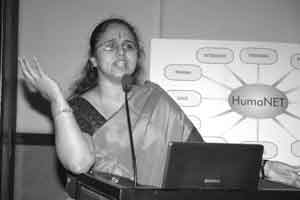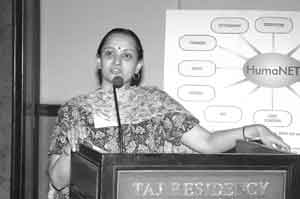 |
The one day conference by HRI Foundation was an interactive and learning experience for CEOs, HR Heads / Learning and Development, Senior and Middle Management executives. The conference focused on the BPO sector and the foothold of the industry especially in India |
Dr.Vasanthi Srinivasan, Associate Professor, IIM Bangalore spoke to the gathering with a presentation on work-life balance. She has been with the IIM for the past five years and her current areas of work are international Human Resource management, careers and special interest in IT and BPO. She gave a more generic perspective and didn't just restrict to HR professionals. Dr.Srinivasan started by speaking about how work-life balance was a never-heard-of concept earlier, say in the 1960s, 70s or 80s. It isn't that they didn't experience stress at work but what it mean and how do you understand it.Organizations have to give a serious thought into this.
Work-life balance is an often-used term in the IT / BPO sector and also in the hospitality sector. The question is ‘What is the theoretical framework when we are looking at work-life balance?' When this is understood, it is easier to crack the problem. Work-life balance is the amount of time you spend at work with the amount of time you spend doing non-work. That is just one dimension of balance. The other dimension is satisfaction balance, which is about the quality of time . Sixty years of literature hasn't answered what makes an employee satisfied and motivated. This whole notion of satisfaction can be seen in the context of time balance or satisfaction balance.
If it is time balance, organizations are easily able to take measures by telling their employees to reach work at 8 am instead of 9. This saves traveling time. But if it is satisfaction balance, the demands are phenomenal. And satisfaction balance is what would be appropriate for the BPO sector to go forward in the next ten years.
|
Challenge related stress impacts positively. Hindrance related stress and poor work-life balance impact negatively. |
Work-life balance comes from being healthy. So when people come to work, it is important that they are healthy. Occupational health can be divided into physical, physiological and emotional. Stress, burnout, work- family conflicts are common. One of the consequences of poor work-life balance in the initial stages is low satisfaction and usually that ends in a stress or a burnout.
It is the balance across the career of an individual in an organization. It isn't about today. It is about retention of employees for twenty or twenty-five years in an organization. And for that we must know what the consequences of poor work-life balance are. All humans experience stress. There can be a challenge related stress and a hindrance related stress . They are identical only in terms of the physiological reactions. The test comes in psychological reactions. If it is positive it is motivating. The same high adrenalin when we're in fear drives in very different ways. Challenge related stress is what we feel when we enter an examination hall or attend an interview. It produces physiological reactions. It also affects body sugar, blood pressure and the heart rate. So not all stress is negative. Challenge related stress motivates individuals.
If you look at stress as emotional, there are solutions like meditation. But if you look at stress as psychological, you think of a therapist and the need for counseling arises. How you address the problem is vital.
High stress-related jobs are those of the policemen, air traffic controllers or nurses. And the stress is because of the unexpectedness in the job. For policemen don't know when a law and order problem will arise. Air traffic controllers are expected to maintain the same level of discrimination for the entire eight-hour shift. You can't slip even for a second. Nurses experience intense stress. You begin to take on what the patient is experiencing.
So stress acts in different ways for different individuals. It is essential to identify individuals in organizations who are vulnerable to stress and manage that. This is the biggest challenge because stress is individual-dependent.
In India, enough of us aren't talking about stress. In ten years, stress will be a bigger issue in India than our notion of work-life balance. Stress, burnout, work-life balance, all the three impact your satisfaction.
What makes for differences across individuals?
1. Personality characteristics (type A and type B). There is phenomenal amount of literature that says individual differences in stress arise out of personality characteristics.
2. Locus of control The extent to which people take responsibility for their actions. People with higher locus of control tend to experience, interestingly, lower stress.
3. Self-efficacy - The extent to which you fulfill your potential and are capable of doing the job you are entrusted with. This is a dimension that directly contributes to work-life balance. There are two aspects to this: confident that you can do the job individually. And the other aspect is you are confident that you will do the job well in a group.Each one of us experience self-efficacy very differently. If you have the necessary knowledge and skills and the capability to do it, you will always experience higher self-efficacy. It plays a very important role in terms of how you experience stress.
4. Self-esteem - positively contributes to work-life balance. Doctors (particularly surgeons, gynecologists) don't really have a work-life balance. A large part of them have a very low time balance but a very high satisfaction balance and their self-esteem is very high.
A study on gynecologists showed that their satisfaction balance was really high because of the satisfaction of creating a new life, which was compensation enough for any kind of time imbalance.
|
The study showed that marital status does not lead to women dropping out but they moved within the industry. |
5. Identity has a direct impact on work-life balance. The stronger the professional identity, the greater the efforts in managing work-life balance. Self-identity appears to be derived from work.
Dr.Srinivasan also shared with us some findings of a study that was done about work-life balance among women IT professionals. A common perception is that women drop out of the work force once they get married. But the study showed that marital status does not lead to women dropping out but they moved within the industry. So marital status does not impact work-life balance but parental status does. When children come into the picture, your work-life balance is noticeably affected. Dependent care also directly impacts work-life balance.
It is usually believed that organizations, which have policies on work-life balance, would tend to have more work-life balance. But it was found that only multi-national organizations had extremely progressive work-life balance. Therefore it was hypothesized that women in multi-national corporations had a higher work-life balance than those in Indian organizations.
The study, grippingly, showed that policies and work-life balance had no relationship. If there was a relationship, it had a lot to do with supervisory support. The immediate supervisor is more critical than the policies related to work-life balance. The company is viable only if they are able to maintain continuity of their employees.
ICICI Bank Ltd is an example for having the largest number of women employees in the banking sector in India. They have a number of options and opportunities.
How you look at a task is very important. Flexible timings and job sharing are popular globally. These are viable options in terms of continuity.
A comparative study on tele marketing was done in Ireland, Hungary and India for a particular multi-national company. The first two countries were far superior on tele working than India. It was found that the reason was not connectivity or communication but the managerial mindset of control. This is the critical driver in your work place.
 |
Ms.Vidya Murthy, Head of Operations (BPO), Code Theatre was the next speaker who focused on emotional stress at the work place. She presented different scenarios goes through. This emotional stress is mainly because you have the responsibility of a family and at the same time you are expected to deliver at your workplace. You need to walk on a tight rope and take the right decision to strike a balance. Each one of us ges through this emotional stress at our work place. How we deal with it, how we go through it, how we come out of it and how we experience it is what neds to be looked upon. Work-life balance is a measure of control; on how, where and when a norm and each one of us whould be the organization and to the individual as well. While recruiting people, they aren't asked about their family life. They are only asked about their education, experience and previour work place. |
Ms.Murthy stressed on the importance of understanding the capacity of a person not just as a candidate for a job but with regard to their family life.
Imagine an x-axis and y-axis. On the x-axis are the satisfaction level, work, family and goals of the individual. On the other axis are the community, friends and relatives. When these are superimposed, you have four quadrants or four different types of people.
1. In the first quadrant you get someone who is extremely selfish and self-driven. You give him a job and he will see to it that it is done extremely well. He is a workaholic. He puts in longer hours at work. You give him that responsibility and it is sure to be done.
2. In the second quadrant, family matters the most to the person. You identify with your family. Work does matter but it isn't as important as the family.
3. In the third quadrant, family and friends matter to the person. But socializing and networking are also important.
4. In the fourth quadrant, work is of utmost importance but networking for work is more important to the person. Family doesn't come in. Business colleagues, business contacts and business friends are all that matters.
When you look at these four types of people, you need to strike a balance to stay at the centre of the graph. Each one of us goes through each of these quadrants at some point in our career. As professionals, we try to strike a balance from within. Like the Darwinian theory says, it is the survival of the fittest.
In a BPO environment, with odd timings and the performance matrix right behind you, your biological clock is muddled up since you are in a stressful setting. Part time employment is also not an option today because it is considered as partial working.
So how do organizations help to make life better for the employee? What can HR do for this? The main thing is to remain humane. Counselors are also being brought into companies. But it is vital that the organizations look into the grass root level of their employee. Nobody wants to invest so much time into one person. This is where their mindset needs to change. HR can help change this common perception by introspecting about how this change can be achieved.
Vaishnavi Vittal is a consulting correspondent for Businessgyan
Issue BG59 Feb06

